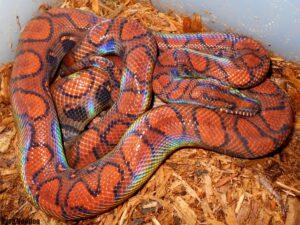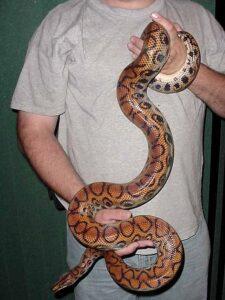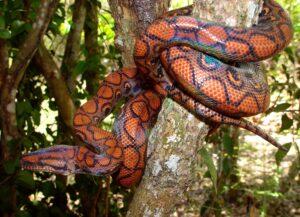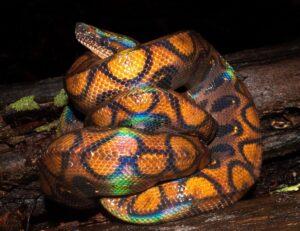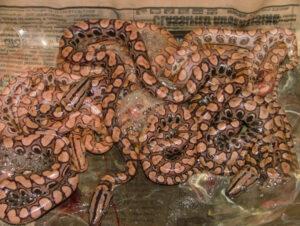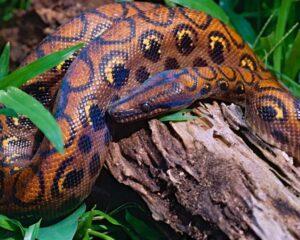Rainbow boa, also known as ‘slender boa’, is one of the most beautiful snake species out there, with a rather colorful body and a distinct iridescent sheen that gets its name. There are 5 recognized subspecies found throughout Central and South America.
Scientific Classifications
- Suborder:Serpentes
- Family:Boidae
- Genus:Epicrates
- Species:E. cenchria
Conservation Status
Subspecies and Morphs
The rainbow boa has 5 subspceis, including the nominate subspecies of the Brazilian Rainbow Boa.
- Marajo Island rainbow boa (E. c. barbouri)
- Brazilian rainbow boa (E. c. cenchria)
- Peruvian rainbow boa (E. c. gaigeae)
- Espirito Santo rainbow boa (E. c. hygrophilus)
- Central highland rainbow boa (E. c. polylepis)
One of the most popular boas to be kept as pets, the rainbow boa has numerous morphs. The most common ones are:
- Ghost
- Calico
- Eugene Calico
- Albino T-
- Leucistic
- Anerythristic
- Wipeout
- Caramel
- Pied
- Pastel
- Hypomelanisitic
- High Red Normals
- Pinstripe
- Bullseye
- Chocolate
- Riso Xanthic
- Picasso Stripe
- Candy StripeTed Thompson Stripe
- Pearl/Zebra Stripe
- Eugene Stripe
Description
Size
They grow up to 4-6 feet in length. Adult females are noticeably longer and broader than males.
Color and Appearance
Its beautiful iridescent color is this soft-skinned snake’s most striking physical feature. Though there are color variations between subspecies, they all have tiny ridges covering their scales that work as tiny prisms to refract light – hence the rainbow sheen.
Are they Dangerous
Like most other boas, these non-venomous snakes do not pose any serious threat to humans. However, they have sharp hooked teeth for tightly gripping their prey, so they can inflict a rather painful bite and even draw blood. But since they are relatively docile, they would not get aggressive unless cornered or mishandled.
Bites are more common when handling or training a new pet rainbow boa.
Rainbow Boa At a Glance
Distribution
From lower Central America to South America, in Costa Rica and Panama, as well as the Amazon River basin, French Guiana, coastal Guyana, southern Venezuela, and Suriname, down to northern Argentina
Habitat
Primarily terrestrial, they prefer hot and humid woodlands and forests but can also be found in savannas.
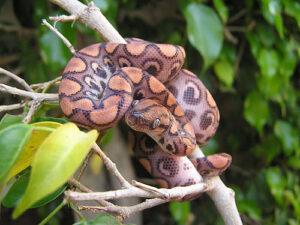
They like to climb up large bushes and trees mainly to rest. Often acknowledged as good swimmers, they may also spend time in waterbodies.
Lifespan
Up to 20-30 years with proper care
Predators
Birds of prey and certain small carnivores
Reproduction
Gives birth to live young (Ovoviviparous)
The snakes reach sexual maturity between 2.5 and 4 years when the males are about 4 feet (1.2 meters) long, and the females are about 4.5 feet (1.4 meters). The males mate with multiple females during their breeding season between November and January. Rainbow boas have a rather long gestation period of around 5 months, after which they give birth to 12-25 hatchlings, about 15-20 inches long.
Care Sheet
Temperament: Docile and occasionally aggressive; need to get used to regular handling
Size of the Enclosure: For younger snakes (up to 2 feet), a 10-20 gallon tank would be enough. Adult snakes need more space, so a 48” x24” x24” enclosure would be ideal.
Substrate: Good quality reptile mulch like coconut husk, cypress mulch, and wood shavings.
Temperature: 70-75°F during the night; 80-85°F during daytime
Lighting: They do not require special UV lighting. A 40W spotlight can be used for the hot spot in the tank, but since these boas do not like to bask, the light need not be left on for long.
FAQs
Ans. They are not suitable for people with no experience in taking care of snakes and reptiles, because these snakes need careful and frequent handling before they can get used to their owner. They can even get pretty aggressive during the initial stage of taming them.
Source
pbs.twimg.com, live.staticflickr.com, oir.mobi, zooinstitutes.com, ball-pythons.net, reptilesmagazine.com, animalia.bio

